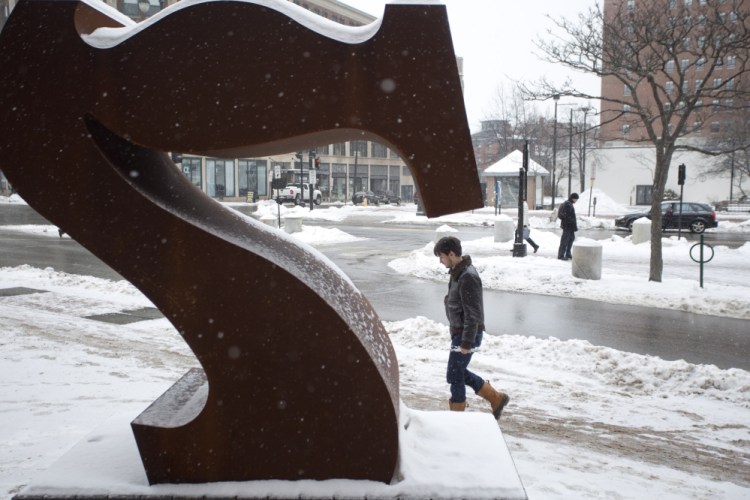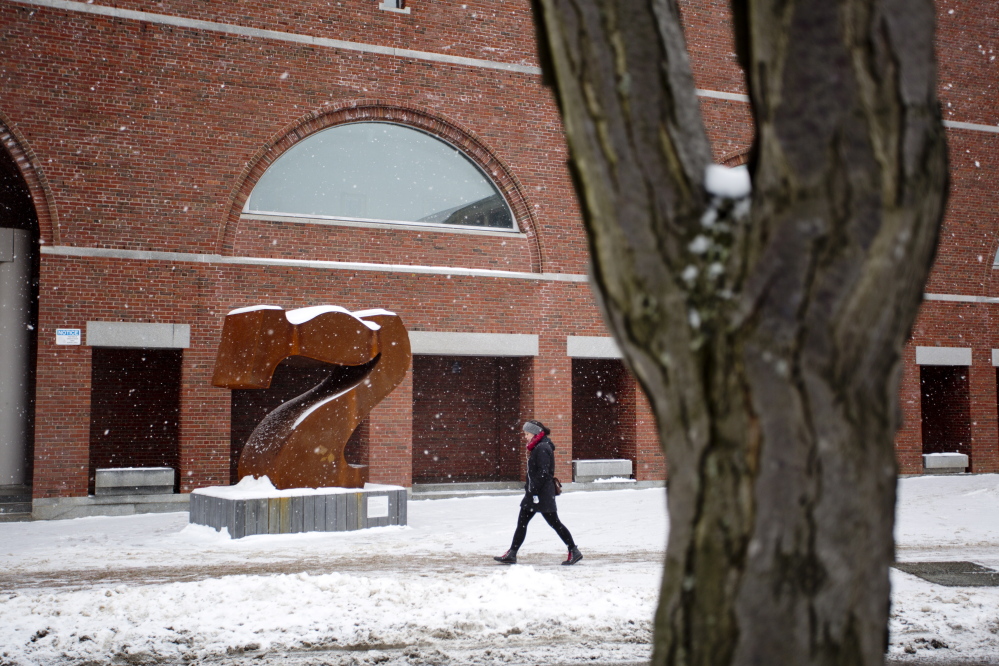The vandalism wasn’t unexpected, but it was demoralizing.
The massive steel “Seven” placed in front of the Portland Museum of Art last fall was tagged with graffiti last month, setting off a conversation within the state’s largest museum of how to balance the obligations of putting art in public places and protecting it at the same time.
The museum placed the 8-foot-tall, rust-colored Robert Indiana sculpture the first week of November in hopes of helping to transform Congress Square, meant almost as a figurehead for a city that sees itself as a place for bold art. Six weeks later, someone had adorned it with an unambiguous message: “(Expletive) art.” Someone else gave it a solid kick to boot.
“As anyone can imagine, we’re disappointed for the museum and the community,” said Mark Bessire, the museum’s director. “We presented a wonderful and important piece of art, and it was defaced. At the same time, we feel strongly that art should be on the inside of the museum and on the outside of the museum. That is what our community expects, and that is what we intend to deliver.”
Both acts of vandalism were caught on surveillance video and are being investigated, a museum spokesman said. The museum discovered the graffiti the morning of Dec. 14.
It hired a team of conservators to inspect and mitigate the damage on “Seven.” They applied a solvent over several days in an attempt to remove the graffiti. It’s still visible, but not noticeable without careful, close-up inspection.
The vandalism has shaken the staff and raised questions about the long-term care of the sculpture and other pieces of public art around Portland. Bessire said he knew the museum needed to acknowledge the graffiti and was preparing to release a statement, but he struggled with just what to say without drawing attention to the vandalism or subjecting the work to copycats.
“It was really painful. It put us all on edge about what it means to work in the public trust,” said chief curator Jessica May. “It was actually mournful. We planned for the possibility that this would happen, but if you are a curator you have to believe that the value of art is a shared public value. Even though we planned for it, it felt like a violation.”
ARTIST SAYS: ‘I AM A TARGET’
Indiana, 86, lives on Vinalhaven island off the coast of Rockland. He is one of the nation’s best-known contemporary artists and is most famous for his “LOVE” sculpture, which became a U.S. postage stamp.
Indiana made a monumental series of numbers in aluminum, “Numbers One through Zero,” for the Indianapolis Museum of Art in 1980. Over the years, he expanded the series to steel.
The museum targeted “Seven” to announce its address at 7 Congress Square, raising about $400,000 for the purchase in the fall.
Reached by phone Thursday at his home on Vinalhaven, Indiana attributed the vandalism to jealousy. “It was probably some local artist who decided, ‘Why am I not in front of the museum instead of that guy?’ ” he said. “I am not surprised. This has happened many times before. I am a target.”
He said the museum’s decision to remove the graffiti was “the only way to go.”
May said the curatorial team evaluated the risk of vandalism when it placed the sculpture outside the museum’s security cordon. It was a risk worth taking, she said, because of the museum’s desire to develop an outdoor art program. The recent vandalism does nothing to lessen the museum’s commitment to Congress Square or outdoor art, she said.
VANDALISM ALWAYS A CONCERN
Lin Lisberger, who chairs Portland’s Public Art Committee, said vandalism is always a concern when considering a proposal to place or commission public art. The jewel-box bus shelter on Congress Street is a frequent target of vandals, but most of the city’s public art collection has been spared, she said.
The bus shelter, designed by Laura Haddad and Tom Drugan and installed in December 2004, was the first commission of the Public Art Committee.
The committee placed several Bernard Langlais wooden sculptures inside this fall. The indoor placement was a requirement of the foundation that provided the money to conserve the pieces, Lisberger said. But it also lessened security risks, she noted.
Copy the Story LinkSend questions/comments to the editors.





Success. Please wait for the page to reload. If the page does not reload within 5 seconds, please refresh the page.
Enter your email and password to access comments.
Hi, to comment on stories you must . This profile is in addition to your subscription and website login.
Already have a commenting profile? .
Invalid username/password.
Please check your email to confirm and complete your registration.
Only subscribers are eligible to post comments. Please subscribe or login first for digital access. Here’s why.
Use the form below to reset your password. When you've submitted your account email, we will send an email with a reset code.